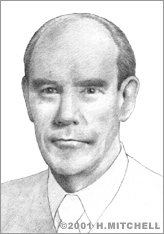Ivan Sutherland
Ivan Sutherland was born in 1938 in Hastings, Nebraska. The child of a civil engineer father, he found it very exciting to discover how things worked. He knew early on that he wanted to be an engineer, and he learned how to program a computer while he was in high school. At the time, that was a very rare skill, especially among high school students.
This was the beginning of a distinguished career in computers, graphics, and integrated circuit design for Sutherland. He went to Carnegie Institute of Technology (now Carnegie Mellon University) on a full scholarship, and earned his BS in Electrical Engineering in 1959. Then, he went to the California Institute of Technology where he earned an MS, and to the Massachusetts Institute of Technology (MIT) to work on his PhD.
Working under computing pioneer Claude Shannon at MIT, Sutherland created a computer program called Sketchpad, which made it possible to create graphic images directly on a display screen by using a hand-held object such as a lightpen. It was the first program that allowed the creation of graphic images directly on a display screen rather than by entering codes and formulas into the computer through a keyboard. Sketchpad provided the foundation for what would become the Graphical User Interface, which is ubiquitous today, having brought to large numbers of discretionary uses the power and utility of the desktop computer.
When Sutherland got out of graduate school in 1963, he was inducted into the Army as First Lieutenant and assigned to the National Security Agency as an electrical engineer. At the time, much of the nation's computing power was concentrated in the military, which measured its computing power "by the acre." In 1964, he was transferred to the Defense Department's Advanced Research Projects Agency (ARPA, later DARPA) to run its Information Processing Techniques office. By then he was just 26 years old.
For the next two years, Sutherland commissioned and managed a variety of contractors in research projects devoted to furthering the field of computer science, including timesharing and artificial intelligence. He stayed with DARPA until 1966 when he was appointed associate professor of electrical engineering at Harvard University. He accepted a professorial position at the University of Utah in 1968, and after meeting and working with Dave Evans, founder of the computer science department there, the two formed a consulting company - Evans and Sutherland - in 1968 in Salt Lake City. They collaborated on a number of computer graphics-related projects, including computer games, which was known as one of the University of Utah's strongholds. Today the company ships $150 million of product per year, is a major developer of computer imaging systems for visualization, and supplies a great deal of visual simulation equipment used for pilot training.
From 1976 to 1980, Sutherland worked for the RAND Corporation, and he also led the department of computer science at the California Institute of Technology. It was there that he began working with Professor Carver Mead on integrated circuit design, making it an official field of academic study. By learning to teach courses in integrated circuit design, they paved the way for colleges to produce a new generation of IC engineers.
From 1980 to 1991 he co-founded and was vice president and technical director of Sutherland, Sproull and Associates. In 1990, Sun bought the company for its patent base and its key people. This acquisition became the nucleus of Sun Microsystems Laboratories.
Dr. Sutherland and his wife Marly Roncken lead the research in Asynchronous Systems at Portland State University. Dr. Sutherland has written over 49 publications. He also holds 12 patents. Over the years, he has won a number of awards for his work, including the Kyoto Prize in 2012, Smithsonian Computer World Award in 1996 and the First Zworykin Award from the National Academy of Engineering in 1972. He is a member of the National Academy of Sciences, National Academy of Engineering, and Institute of Electrical and Electronic Engineers and is a Fellow with the Association for Computing Machinery.


